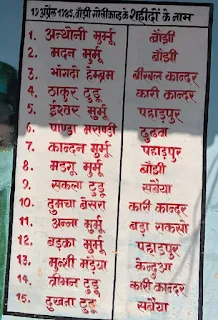In the annals of Indian history, some events witness the struggles of discontented sections of society, where they confront ruling forces. These events become a reminder of the struggles of unequal communities. They are often recorded as a tragic chapter in the hands of authorities, eventually being etched into the pages of history.
The Banjhi Firing Incident, which still lingers in the memories of the tribal people residing in Banjhi village, is one such tragic event.
The Banjhi Massacre, also known as the Banjhi Firing Incident, was an uprising against judicial oppression, exploitation, and land grabbing, faced by the tribal communities of India. This event occurred on April 19, 1985, when the police fired upon a group of tribal protesters, killing 15 people, including former Member of Parliament Father Anthony Murmu. The Banjhi Firing Incident symbolized the tribals' fight against hunger, poverty, and exploitation. On April 19, 1985, the police shot 15 tribals, including former MP Father Anthony Murmu. During this violent conflict, the police fired 80 rounds for about half an hour.
This police firing caught the attention of the Lok Sabha (the Indian Parliament), and the Prime Minister appointed an officer named Ram Dulari Sinha to investigate the case. In defense of the firing, the police claimed that the tribal crowd had first attacked them with bows and arrows, and in retaliation, the police fired 80 rounds.
The Santhal Pargana region is a tribal-dominated area. In terms of population, the region is predominantly inhabited by the Santhal tribal community and the Sadan (non-tribal natives). Due to its proximity to the neighboring state of Bihar, caste-based struggles and feudalism are also observed among the non-tribal classes.
During the 1980s, there were four major timber traders in Banjhi: Moti Bhagat, Madan Bhagat, Kaiyum Miyan, and Badri Bhagat. All of them had licenses from the government to trade timber. They bought wood from the tribals at low prices and sold it at higher rates. This business activity, along with forest guard Eric Hansda, was causing increasing dissatisfaction among the tribals.
During this period, the lease of the Banjhi market pond was transferred to Moti Bhagat, a powerful figure. The tribals had been fishing in the pond for years, but after the lease was granted, Moti allowed them access to only a small portion for fishing. Then, one day, the mutilated body of Matru Murmu was found in the pond, which sparked immense outrage among the tribals.
In the wake of this outrage, on March 25, 1985, the tribals attacked Moti Bhagat's house and warehouse. Considering the seriousness of the situation, the police filed a murder case against Moti Bhagat under Section 302 of the Indian Penal Code, but before he could be arrested, Moti Bhagat mysteriously fled.
On March 25-26, 1985, the District Commissioner, Baghambar Prasad, and the Sub-Divisional Officer visited Banjhi village. The administration deployed armed forces in the village. In protest, large numbers of tribals from nearby villages like Aprol, Savayya, Paharpur, Birbalkandar, and Devpahad began to gather, carrying traditional weapons like drums, bows, and arrows. Government officials camped in the Panchayat building, where discussions began between former MP Father Anthony Murmu, Madan Murmu, Jetha Murmu, and the administrative officials.
Meanwhile, the enraged mob set fire to Shyamal De, Lal Sah, and the post office. Seeing the situation deteriorating, the Sub-Divisional Officer ordered the police to open fire, which resulted in the martyrdom of 15 people, including the former MP.
Later, the administration seized the bodies of the martyrs for post-mortem. After the post-mortem, the bodies were not returned to the families. People claimed that the authorities were trying to suppress the incident and did not act fairly. Instead of handing over the bodies to the families, the administration threw them into the Ganges River.
.





.jpg)

